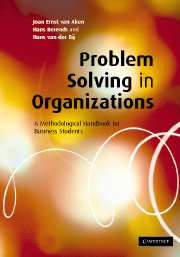Book contents
- Frontmatter
- Contents
- List of figures
- List of boxes
- Preface
- Part I Fundamentals
- Part II The problem-solving project
- 5 Intake and orientation
- 6 Theory-based diagnosis of business problems
- 7 Solution design
- 8 Change plan design and the actual change process
- 9 Evaluation, reflection and termination
- Part III On methods
- Part IV Conclusion
- References
- Index
8 - Change plan design and the actual change process
from Part II - The problem-solving project
Published online by Cambridge University Press: 04 December 2009
- Frontmatter
- Contents
- List of figures
- List of boxes
- Preface
- Part I Fundamentals
- Part II The problem-solving project
- 5 Intake and orientation
- 6 Theory-based diagnosis of business problems
- 7 Solution design
- 8 Change plan design and the actual change process
- 9 Evaluation, reflection and termination
- Part III On methods
- Part IV Conclusion
- References
- Index
Summary
The timing of change plan design
At the time of formal go-no/go decision making on the designed solution, one should also make decisions on the change process itself. That decision-making should be based on a change plan, specifying the various actions to be taken, the actors that are to execute those actions, and the actors that should get involved in the process. Decision-making on realization concerns the authorization of the change plan (after possible amendments) and the assignment of people to the planned actions by the managers responsible (normally according to the proposals in the change plan).
The change plan should be made before the formal go-no/go decision-making. In fact, change planning should start right at the beginning of the project. Every business problem is embedded in a political-cultural environment, of which the student forms a part. The mere fact that the student enters the organization to work on a certain problem already has an impact, among other things because it increases the awareness and perceived importance of the problem in question. Quite early in the project the student should make a potential stakeholder analysis: which people are expected to be the direct stakeholders, that is, people whose work processes, roles or vital interests are directly affected by the problem or by possible solutions, and which people are the indirect stakeholders, that is, the people who are to cooperate with the direct stakeholders and therefore need to know about the problem and about the changes in roles and processes of the direct stakeholders.
Information
- Type
- Chapter
- Information
- Problem Solving in OrganizationsA Methodological Handbook for Business Students, pp. 98 - 112Publisher: Cambridge University PressPrint publication year: 2007
